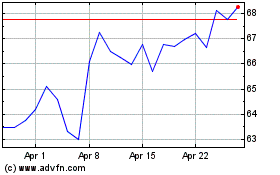Rio Tinto U.S. Borax becomes first open pit mine to transition to renewable diesel
June 02 2023 - 11:03AM
Business Wire
Rio Tinto has successfully completed the full transition of its
heavy machinery from fossil diesel to renewable diesel at its
Boron, California operation, making it the first open pit mine in
the world to achieve this milestone. The change to renewable diesel
brings an anticipated CO2 equivalent reduction of up to 45,000
tonnes per year, comparable to eliminating the annual emissions of
approximately 9,600 cars.
Rio Tinto Minerals Chief Executive Sinead Kaufman said: “We are
proud that our U.S. Borax operations have become the first open pit
mine to operate a fleet running entirely on renewable diesel. This
is an excellent example of what happens when internal and external
partners collaborate toward a carbon reduction goal. Support from
the state of California has also been incredibly important, as
without their vision, this would not have been possible.”
“The transition at Boron is an important first step and will
undoubtedly lead to further opportunities to decarbonise our global
operations. Renewable diesel is one of several sustainability
solutions that Rio Tinto is using to transform its businesses.”
An initial trial of switching fossil diesel to renewable diesel
in a U.S. Borax haul truck was conducted through 2022 in
partnership with Neste and Rolls-Royce. Rio Tinto U.S. Borax used
Neste MY Renewable Diesel™ during the trial. Made from sustainably
sourced, 100% renewable raw materials such as used cooking oil and
animal fat waste, the use of Neste MY Renewable DieselTM can reduce
greenhouse gas emissions by up to 75% over the life cycle of the
fuel compared to fossil diesel*. Results from the trial showed that
a truck running on renewable diesel delivered similar performance
and reliability as trucks running on conventional diesel.
Based on these positive results, Rio Tinto U.S. Borax continued
to work with Rolls-Royce, Neste, the Environmental Protection
Agency, and the State of California to fully transition its heavy
machinery fleet onsite to renewable diesel at the end of May 2023.
This transition includes all the heavy machinery on the property
from haul trucks to loaders, and the renewable diesel is even used
in blasting.
This conversion to renewable diesel supports Rio Tinto’s global
decarbonization objectives, which include a 50 per cent reduction
in Scope 1 & 2 emissions by 2030, and a commitment to reach net
zero by 2050. The company estimates carbon emissions from the use
of diesel in its mobile fleet and rail accounted for 13% of its
Scope 1 & 2 emissions in 2022.
Notes to editors
As agreed in the lead up to Rio Tinto’s 2023 Annual General
Meetings, a briefing paper on the Group's approach to diesel
transition will be published on riotinto.com in the third
quarter.
* The GHG emission reduction percentage varies depending on the
region-specific legislation that provides the methodology for the
calculations (e.g. EU RED II 2018/2001/EU for Europe and U.S.
California LCFS for the U.S.), and the raw material mix used to
manufacture the product for each market.
View source
version on businesswire.com: https://www.businesswire.com/news/home/20230602005220/en/
Please direct all enquiries to
media.enquiries@riotinto.com
Media Relations, United Kingdom Matthew Klar
M +44 7796 630 637 David Outhwaite M +44 7787 597
493
Media Relations, Australia Matt Chambers M
+61 433 525 739 Jesse Riseborough M +61 436 653 412
Alyesha Anderson M +61 434 868 118
Media Relations, Americas Simon Letendre M
+1 514 796 4973 Malika Cherry M +1 418 592 7293
Investor Relations, United Kingdom Menno Sanderse
M +44 7825 195 178 David Ovington M +44 7920
010 978 Danielle Smith M +44 7788 190 672
Investor Relations, Australia Tom Gallop M
+61 439 353 948 Amar Jambaa M +61 472 865 948
Rio Tinto plc 6 St James’s Square London SW1Y 4AD United
Kingdom T +44 20 7781 2000 Registered in England No.
719885
Rio Tinto Limited Level 43, 120 Collins Street Melbourne
3000 Australia T +61 3 9283 3333 Registered in Australia ABN
96 004 458 404
riotinto.com
Category: Boron
Rio Tinto (NYSE:RIO)
Historical Stock Chart
From Mar 2024 to Apr 2024

Rio Tinto (NYSE:RIO)
Historical Stock Chart
From Apr 2023 to Apr 2024
